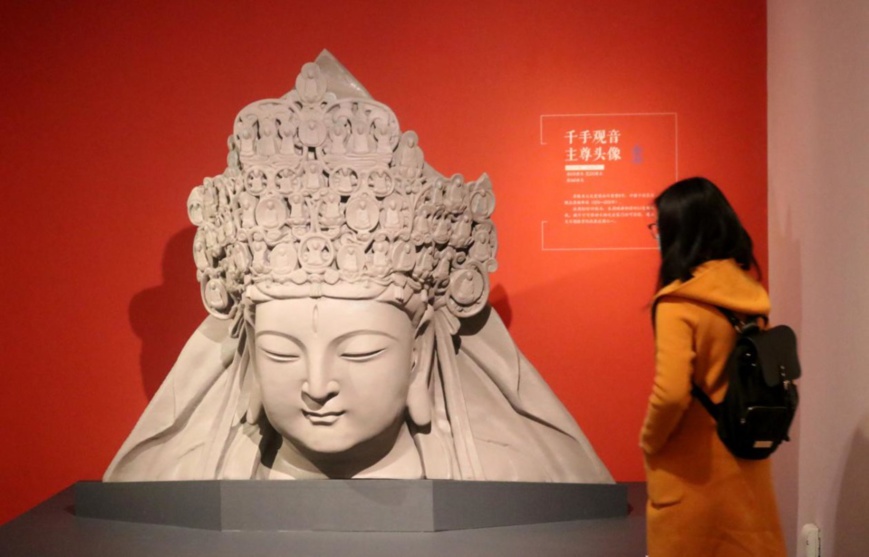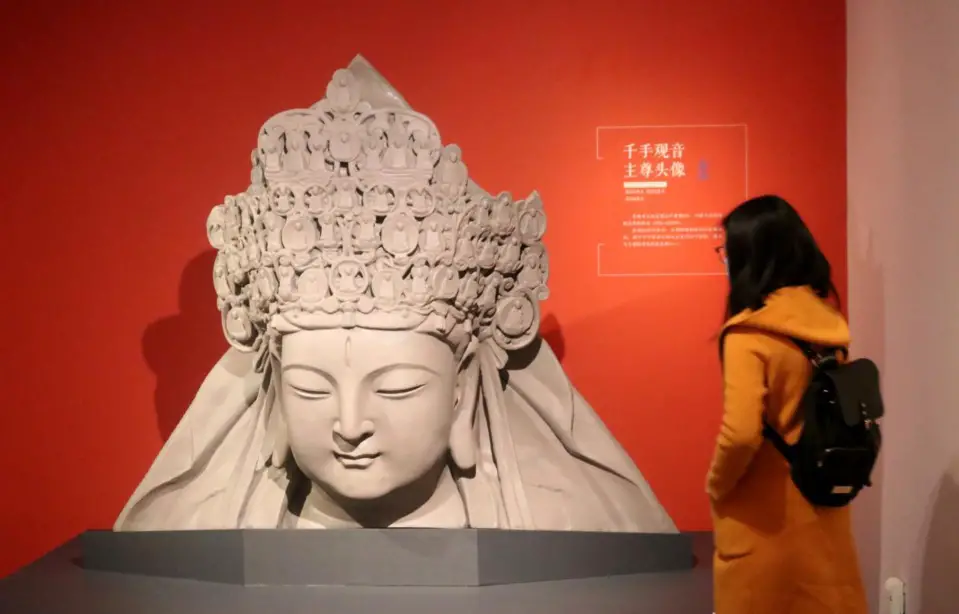By Wang Jue, People’s Daily

Photo shows a visitor appreciate artwork from the Dazu Rock Carvings scenic area in southwest China’s Chongqing municipality, at Suzhou Museum in Suzhou, east China’s Jiangsu province, Jan. 31. (Photo by Wang Jiankang/People’s Daily Online)
China witnessed rich fruits of its endeavors to protect and make better use of cultural relics during its 13th Five-Year Plan period (2016-2020).
During the period, the country completed its first national survey of movable cultural relics, achieved notable results in cracking down on cultural relic-related crimes, saw important archaeological discoveries constantly, helped more people get better knowledge about China’s history and culture through cultural relics, and retrieved thousands of lost cultural relics from foreign lands.
Although China has carried out three nationwide surveys of immovable cultural relics, the census on movable cultural relics, which is described by some as “a systematic program that never ends”, represents a new endeavor of the country to protect its cultural artifacts.
China has assigned 107,000 enumerators and allocated funds totaling nearly 1.25 billion yuan (about $193 million) to its first national survey of moveable cultural artifacts, during which 1.02 million state-owned units were investigated and 108.15 million items or sets of cultural artifacts owned by the state were registered.
The survey has basically formed a clear picture of the country’s state-owned movable cultural artifacts, said Guan Qiang, deputy head of China’s National Cultural Heritage Administration (NCHA).
So far, the country has as many as 5,058 key historical and cultural sites protected at the national level, more than 20,000 such sites under provincial-level protection, and over 110,000 sites protected at the municipal or county level.
During the past five years, China made great efforts to ensure the safety of cultural relics. The central government and provincial governments provided an average of more than 1 billion yuan per year for cultural relics protection projects.
A total of 23 provincial-level regions in China have included the safety of cultural relics into the performance assessment system of local governments.
In addition, the NCHA have teamed up with China’s Ministry of Public Security to constantly carry out special campaigns to combat cultural relic-related crimes. They have issued five batches of class-A arrest warrants for fugitives involved in cultural relic-related crimes, dismantled more than 700 cultural relics criminal gangs, arrested over 6,000 suspects and seized more than 60,000 pieces of cultural relics involved in relevant crimes.
In recent years, a total of 4,260 archaeological excavation projects have been carried out in China in an orderly manner, with important archaeological discoveries being made constantly in a batch of major historical sites, including the Archaeological Ruins of Liangzhu City in Hangzhou, east China’s Zhejiang province, and the Shimao ruins in northwest China’s Shaanxi province. Efforts to protect and excavate the tomb of the “Marquis of Haihun” in east China’s Jiangxi province have attracted wide attention.
At the same time, museums across the country have seen a fast-growing number of visitors. According to reliable data, as of the end of 2019, the number of registered museums in China reached 5,535. In 2019, museums in the country received a total of nearly 1.23 billion person-times of visitors.
Besides museums, cultural and historical sites and facilities in the country have also seen more and more visitors.
During the 13th Five-year Plan period, 36 national archaeological parks in China received 34.6 million person-times of visitors, and various world cultural heritage sites in the country were visited by more than 300 million people.
China also achieved rich fruits in international cooperation in archaeology during the past five years. The country has by far provided assistance for 11 cultural relic protection projects overseas and carried out more than 40 joint archaeological projects with 24 countries from Asia, Africa, Europe, and South America.
In recent years, the country has made active efforts to advance the recovery and return of lost cultural relics in an orderly manner, contributing practices and strength to the establishment of fairer and more just international rules for the retrieval of lost cultural relics.
Thanks to its unremitting efforts, a lot of lost cultural relics have been returned to China, including artworks recovered from Italy, and the well-known bronze horse head sculpture, a treasure of China’s Old Summer Palace. The return of lost cultural artifacts to their original home has aroused wide attention.
According to statistics, foreign countries including the U.S., Italy and Japan have accumulatively returned more than 1,000 items or sets of cultural relics to China, and about 23 countries have signed bilateral inter-governmental agreements with China on preventing theft, clandestine excavation and illicit import and export of cultural property.
During the past five years, a bunch of Chinese historical and cultural sites were inscribed on the United Nations Educational, Scientific and Cultural Organization (UNESCO) World Heritage List, including the Zuojiang Huashan rock-art cultural landscape in south China’s Guangxi Zhuang autonomous region, Kulangsu, a Historic International Settlement in Xiamen, east China’s Fujian province, and the Archaeological Ruins of Liangzhu City.
While its total number of world heritage sites reached 55, the highest in the world, China has been constantly ramping up efforts to improve its capabilities to protect, preserve, and display cultural relics, which has effectively promoted global recognition and influence of the country and made the country with an ancient civilization a true major country with rich cultural relics.
During the period, the country completed its first national survey of movable cultural relics, achieved notable results in cracking down on cultural relic-related crimes, saw important archaeological discoveries constantly, helped more people get better knowledge about China’s history and culture through cultural relics, and retrieved thousands of lost cultural relics from foreign lands.
Although China has carried out three nationwide surveys of immovable cultural relics, the census on movable cultural relics, which is described by some as “a systematic program that never ends”, represents a new endeavor of the country to protect its cultural artifacts.
China has assigned 107,000 enumerators and allocated funds totaling nearly 1.25 billion yuan (about $193 million) to its first national survey of moveable cultural artifacts, during which 1.02 million state-owned units were investigated and 108.15 million items or sets of cultural artifacts owned by the state were registered.
The survey has basically formed a clear picture of the country’s state-owned movable cultural artifacts, said Guan Qiang, deputy head of China’s National Cultural Heritage Administration (NCHA).
So far, the country has as many as 5,058 key historical and cultural sites protected at the national level, more than 20,000 such sites under provincial-level protection, and over 110,000 sites protected at the municipal or county level.
During the past five years, China made great efforts to ensure the safety of cultural relics. The central government and provincial governments provided an average of more than 1 billion yuan per year for cultural relics protection projects.
A total of 23 provincial-level regions in China have included the safety of cultural relics into the performance assessment system of local governments.
In addition, the NCHA have teamed up with China’s Ministry of Public Security to constantly carry out special campaigns to combat cultural relic-related crimes. They have issued five batches of class-A arrest warrants for fugitives involved in cultural relic-related crimes, dismantled more than 700 cultural relics criminal gangs, arrested over 6,000 suspects and seized more than 60,000 pieces of cultural relics involved in relevant crimes.
In recent years, a total of 4,260 archaeological excavation projects have been carried out in China in an orderly manner, with important archaeological discoveries being made constantly in a batch of major historical sites, including the Archaeological Ruins of Liangzhu City in Hangzhou, east China’s Zhejiang province, and the Shimao ruins in northwest China’s Shaanxi province. Efforts to protect and excavate the tomb of the “Marquis of Haihun” in east China’s Jiangxi province have attracted wide attention.
At the same time, museums across the country have seen a fast-growing number of visitors. According to reliable data, as of the end of 2019, the number of registered museums in China reached 5,535. In 2019, museums in the country received a total of nearly 1.23 billion person-times of visitors.
Besides museums, cultural and historical sites and facilities in the country have also seen more and more visitors.
During the 13th Five-year Plan period, 36 national archaeological parks in China received 34.6 million person-times of visitors, and various world cultural heritage sites in the country were visited by more than 300 million people.
China also achieved rich fruits in international cooperation in archaeology during the past five years. The country has by far provided assistance for 11 cultural relic protection projects overseas and carried out more than 40 joint archaeological projects with 24 countries from Asia, Africa, Europe, and South America.
In recent years, the country has made active efforts to advance the recovery and return of lost cultural relics in an orderly manner, contributing practices and strength to the establishment of fairer and more just international rules for the retrieval of lost cultural relics.
Thanks to its unremitting efforts, a lot of lost cultural relics have been returned to China, including artworks recovered from Italy, and the well-known bronze horse head sculpture, a treasure of China’s Old Summer Palace. The return of lost cultural artifacts to their original home has aroused wide attention.
According to statistics, foreign countries including the U.S., Italy and Japan have accumulatively returned more than 1,000 items or sets of cultural relics to China, and about 23 countries have signed bilateral inter-governmental agreements with China on preventing theft, clandestine excavation and illicit import and export of cultural property.
During the past five years, a bunch of Chinese historical and cultural sites were inscribed on the United Nations Educational, Scientific and Cultural Organization (UNESCO) World Heritage List, including the Zuojiang Huashan rock-art cultural landscape in south China’s Guangxi Zhuang autonomous region, Kulangsu, a Historic International Settlement in Xiamen, east China’s Fujian province, and the Archaeological Ruins of Liangzhu City.
While its total number of world heritage sites reached 55, the highest in the world, China has been constantly ramping up efforts to improve its capabilities to protect, preserve, and display cultural relics, which has effectively promoted global recognition and influence of the country and made the country with an ancient civilization a true major country with rich cultural relics.
 Menu
Menu
 China sees notable achievements in protection and utilization of cultural relics over past five years
China sees notable achievements in protection and utilization of cultural relics over past five years
















